Lancia Voyager 2013 Owner handbook (in English)
Manufacturer: LANCIA, Model Year: 2013, Model line: Voyager, Model: Lancia Voyager 2013Pages: 360, PDF Size: 4.21 MB
Page 81 of 360

SMOKER'S PACKAGE KIT(for versions/markets, where provided) . . . . . .147
STORAGE . . . . . . . . . . . . . . . . . . . . . . . . . . . . . . .148
GLOVE COMPARTMENTS . . . . . . . . . . . . . . . .148
DOOR TRIM PANEL STORAGE . . . . . . . . . . . .148
DRIVER SEATBACK STORAGE(for versions/markets, where provided) . . . . . .148
UMBRELLA HOLDER . . . . . . . . . . . . . . . . . . .148
SECOND ROW FLOOR STORAGE BINS . . . . . .149
STORAGE BIN SAFETY WARNING . . . . . . . . . .149
CENTER AND REAR OVERHEAD CONSOLE STORAGE
(for version/markets, where provided) . . . . . . .150
COAT HOOKS . . . . . . . . . . . . . . . . . . . . . . . . .150
CARGO AREA STORAGE . . . . . . . . . . . . . . . . .151
CONSOLE FEATURES . . . . . . . . . . . . . . . . . . . . .151
BASIC CONSOLE . . . . . . . . . . . . . . . . . . . . . . .151
PREMIUM CONSOLE(for versions/markets, where provided) . . . . . .152
SUPER CONSOLE (for versions/markets, where provided) . . . . . .154
CARGO AREA FEATURES . . . . . . . . . . . . . . . . . .154
RECHARGEABLE FLASHLIGHT(for versions/markets, where provided) . . . . . .154
REAR WINDOW FEATURES . . . . . . . . . . . . . . . .155
REAR WINDOW DEFROSTER . . . . . . . . . . . . .155
75
Page 82 of 360
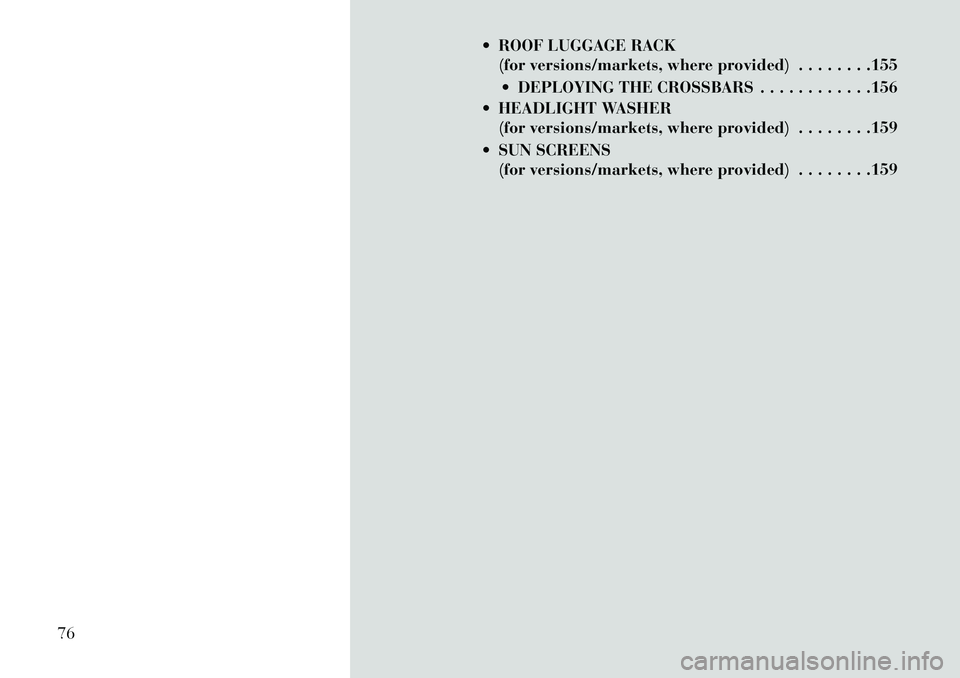
ROOF LUGGAGE RACK(for versions/markets, where provided) . . . . . . . .155
DEPLOYING THE CROSSBARS . . . . . . . . . . . .156
HEADLIGHT WASHER (for versions/markets, where provided) . . . . . . . .159
SUN SCREENS (for versions/markets, where provided) . . . . . . . .159
76
Page 83 of 360

MIRRORS
INSIDE DAY/NIGHT
MIRROR (for versions/
markets, where provided)
A two-point pivot system allows for
horizontal and vertical adjustment of
the mirror. Adjust the mirror to center
on the view through the rear window.
Headlight glare can be reduced by
moving the small control under the
mirror to the night position (toward
the rear of the vehicle). The mirror
should be adjusted while set in the day
position (toward the windshield).AUTOMATIC DIMMING
MIRROR (for versions/
markets, where provided)
This mirror automatically adjusts for
headlight glare from vehicles behind
you. You can turn the feature on or off
by pressing the button at the base of
the mirror. A light to the left of the
button will illuminate to indicate
when the dimming feature is acti-
vated. The sensor to the right of the
button does not illuminate.
NOTE: This feature is disabled
when the vehicle is moving in re-
verse.
CAUTION!
To avoid damage to the mirror dur-
ing cleaning, never spray any
cleaning solution directly onto the
mirror. Apply the solution onto a
clean cloth and wipe the mirror
clean.
OUTSIDE MIRRORS
To receive maximum benefit, adjust
the outside mirror(s) to center on the
adjacent lane of traffic with a slight
overlap of the view obtained on the
inside mirror.WARNING!
Vehicles and other objects seen in
an outside convex mirror will look
smaller and farther away than they
really are. Relying too much on side
convex mirrors could cause you to
collide with another vehicle or
other object. Use your inside mirror
when judging the size or distance of
a vehicle seen in a side convex mir-
ror.
Manual Rearview Mirror
Automatic Dimming Mirror
77
Page 84 of 360
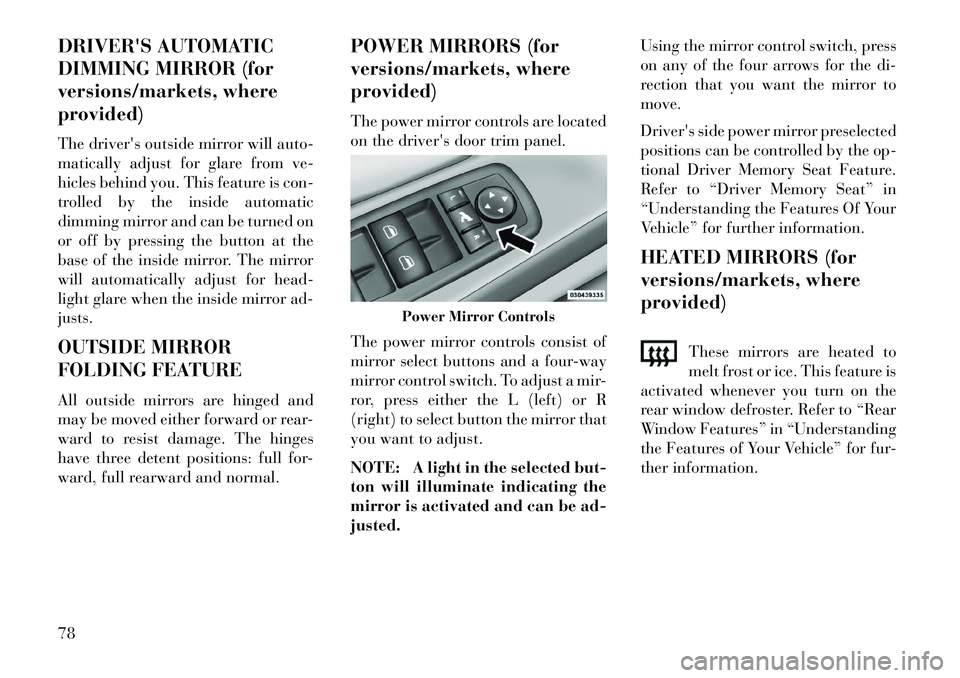
DRIVER'S AUTOMATIC
DIMMING MIRROR (for
versions/markets, where
provided)
The driver's outside mirror will auto-
matically adjust for glare from ve-
hicles behind you. This feature is con-
trolled by the inside automatic
dimming mirror and can be turned on
or off by pressing the button at the
base of the inside mirror. The mirror
will automatically adjust for head-
light glare when the inside mirror ad-
justs.
OUTSIDE MIRROR
FOLDING FEATURE
All outside mirrors are hinged and
may be moved either forward or rear-
ward to resist damage. The hinges
have three detent positions: full for-
ward, full rearward and normal.POWER MIRRORS (for
versions/markets, where
provided)
The power mirror controls are located
on the driver's door trim panel.
The power mirror controls consist of
mirror select buttons and a four-way
mirror control switch. To adjust a mir-
ror, press either the L (left) or R
(right) to select button the mirror that
you want to adjust.
NOTE: A light in the selected but-
ton will illuminate indicating the
mirror is activated and can be ad-
justed.Using the mirror control switch, press
on any of the four arrows for the di-
rection that you want the mirror to
move.
Driver's side power mirror preselected
positions can be controlled by the op-
tional Driver Memory Seat Feature.
Refer to “Driver Memory Seat” in
“Understanding the Features Of Your
Vehicle” for further information.
HEATED MIRRORS (for
versions/markets, where
provided)
These mirrors are heated to
melt frost or ice. This feature is
activated whenever you turn on the
rear window defroster. Refer to “Rear
Window Features” in “Understanding
the Features of Your Vehicle” for fur-
ther information.
Power Mirror Controls
78
Page 85 of 360

TILT MIRRORS IN
REVERSE (available with
memory seat only), (for
versions/markets, where
provided)
Tilt Mirrors in Reverse provides auto-
matic outside mirror positioning
which will aid the drivers view of the
ground rearward of the front doors.
The driver's outside mirror will move
slightly downward from the present
position when the vehicle is shifted
into REVERSE. The driver's outside
mirror will then return to the original
position when the vehicle is shifted
out of REVERSE position. Each
stored memory setting will have an
associated Tilt Mirrors in Reverse po-
sition.
NOTE: The Tilt Mirrors in Re-
verse feature is not enabled when
delivered from the factory. The Tilt
Mirrors in Reverse feature can be
enabled or disabled in the Elec-
tronic Vehicle Information Center
(EVIC). Refer to “Electronic Ve-
hicle Information Center (EVIC)/Customer-Programmable Fea-
tures” in “Understanding Your
Instrument Panel” for further in-
formation.
POWER FOLDING
MIRRORS (for
versions/markets, where
provided)
The switch for the power folding mir-
rors is located between the power mir-
ror switches L (left) and R (right).
Press the switch once and the mirrors
will fold in, pressing the switch a sec-
ond time will return the mirrors to the
normal driving position.
If the mirrors are in the folded posi-
tion, and vehicle speed is equal or
greater than 16 km/h, they will auto-
matically unfold.
ILLUMINATED VANITY
MIRRORS (for
versions/markets, where
provided)
An illuminated vanity mirror is lo-
cated on the sun visor. To use the
mirror, rotate the sun visor down and
swing the mirror cover upward. The
lights turn on automatically. Closing
the mirror cover turns off the lights.
Power Folding Mirror Switch
Illuminated Mirror
79
Page 86 of 360

BLIND SPOT
MONITORING (for
versions/markets, where
provided)
The Blind Spot Monitoring (BSM)
system uses two radar-based sensors,
located inside the rear bumper fascia,
to detect highway licensable vehicles
(automobiles, trucks, motorcycles,
etc.) that enter the blind spot zones
from the rear/front/side of the ve-
hicle.
When the vehicle is started, the BSM
warning light will momentarily illu-
minate in both outside rear view mir-
rors to let the driver know that the
system is operational. The BSM sys-
tem sensors operate when the vehicleis in any forward gear or REVERSE
and enters stand-by mode when the
vehicle is in PARK.
The BSM detection zone covers ap-
proximately one lane on both sides of
the vehicle or 3.35 m. The zone starts
at the outside rear view mirror and
extends approximately 6 m to the rear
of the vehicle. The BSM system moni-
tors the detection zones on both sides
of the vehicle when the vehicle speed
reaches approximately 10 km/h or
higher and will alert the driver of ve-
hicles in these areas.
NOTE:
The BSM system does NOT alert
the driver about rapidly ap-
proaching vehicles that are out-
side the detection zones.
The BSM system detection zone DOES NOT change if your ve-
hicle is towing a trailer. There-
fore, visually verify the adjacent
lane is clear for both your ve-
hicle and trailer before making
a lane change. If the trailer or
other object (i.e., bicycle, sports equipment) extends beyond the
side of your vehicle, this may re-
sult in the BSM warning light
remaining illuminated the en-
tire time the vehicle is in a for-
ward gear.
The area on the rear fascia where the
radar sensors are located must remain
free of snow, ice, and dirt/road con-
tamination so that the BSM system
can function properly. Do not block
the area of the rear fascia where the
radar sensors are located with foreign
objects (bumper stickers, bicycle
racks, etc.).
Rear Detection Zones
Sensor Locations
80
Page 87 of 360
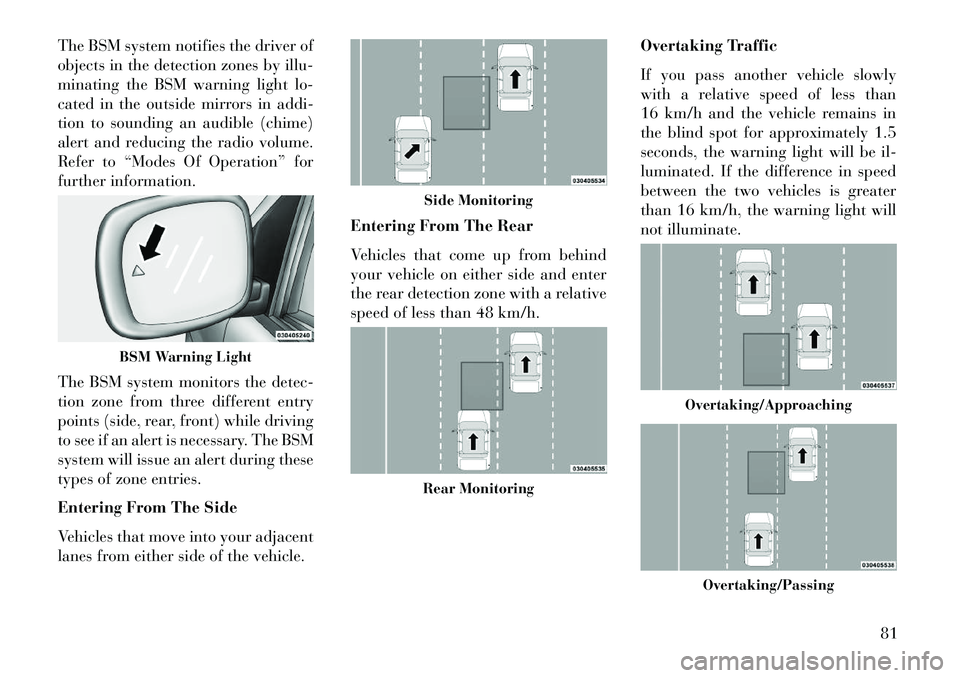
The BSM system notifies the driver of
objects in the detection zones by illu-
minating the BSM warning light lo-
cated in the outside mirrors in addi-
tion to sounding an audible (chime)
alert and reducing the radio volume.
Refer to “Modes Of Operation” for
further information.
The BSM system monitors the detec-
tion zone from three different entry
points (side, rear, front) while driving
to see if an alert is necessary. The BSM
system will issue an alert during these
types of zone entries.
Entering From The Side
Vehicles that move into your adjacent
lanes from either side of the vehicle.Entering From The Rear
Vehicles that come up from behind
your vehicle on either side and enter
the rear detection zone with a relative
speed of less than 48 km/h.
Overtaking Traffic
If you pass another vehicle slowly
with a relative speed of less than
16 km/h and the vehicle remains in
the blind spot for approximately 1.5
seconds, the warning light will be il-
luminated. If the difference in speed
between the two vehicles is greater
than 16 km/h, the warning light will
not illuminate.
BSM Warning Light
Side MonitoringRear Monitoring
Overtaking/Approaching
Overtaking/Passing
81
Page 88 of 360
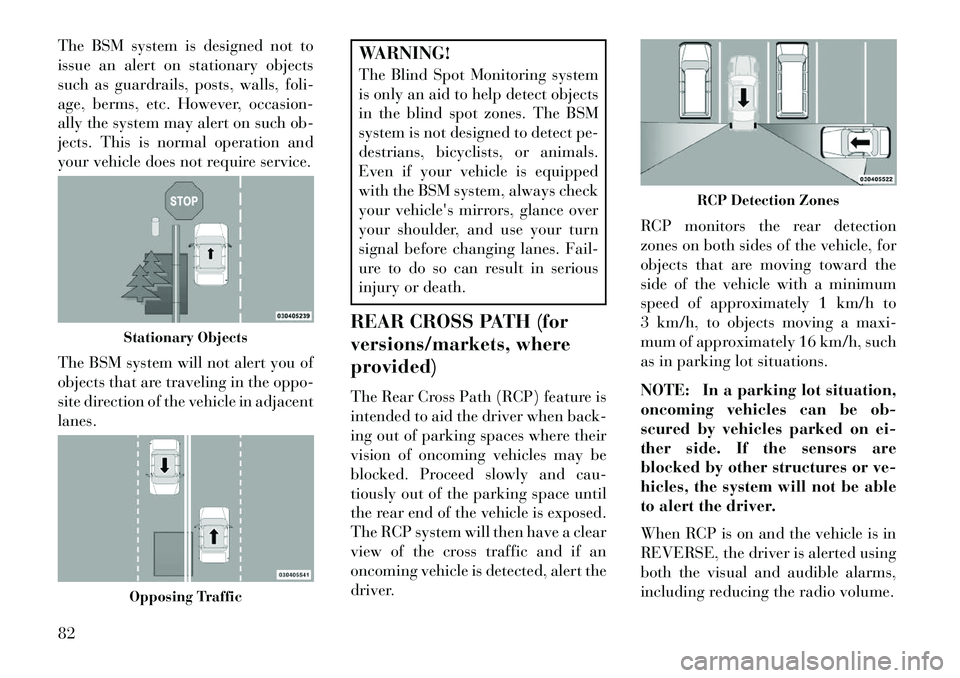
The BSM system is designed not to
issue an alert on stationary objects
such as guardrails, posts, walls, foli-
age, berms, etc. However, occasion-
ally the system may alert on such ob-
jects. This is normal operation and
your vehicle does not require service.
The BSM system will not alert you of
objects that are traveling in the oppo-
site direction of the vehicle in adjacent
lanes.
WARNING!
The Blind Spot Monitoring system
is only an aid to help detect objects
in the blind spot zones. The BSM
system is not designed to detect pe-
destrians, bicyclists, or animals.
Even if your vehicle is equipped
with the BSM system, always check
your vehicle's mirrors, glance over
your shoulder, and use your turn
signal before changing lanes. Fail-
ure to do so can result in serious
injury or death.
REAR CROSS PATH (for
versions/markets, where
provided)
The Rear Cross Path (RCP) feature is
intended to aid the driver when back-
ing out of parking spaces where their
vision of oncoming vehicles may be
blocked. Proceed slowly and cau-
tiously out of the parking space until
the rear end of the vehicle is exposed.
The RCP system will then have a clear
view of the cross traffic and if an
oncoming vehicle is detected, alert the
driver. RCP monitors the rear detection
zones on both sides of the vehicle, for
objects that are moving toward the
side of the vehicle with a minimum
speed of approximately 1 km/h to
3 km/h, to objects moving a maxi-
mum of approximately 16 km/h, such
as in parking lot situations.
NOTE: In a parking lot situation,
oncoming vehicles can be ob-
scured by vehicles parked on ei-
ther side. If the sensors are
blocked by other structures or ve-
hicles, the system will not be able
to alert the driver.
When RCP is on and the vehicle is in
REVERSE, the driver is alerted using
both the visual and audible alarms,
including reducing the radio volume.
Stationary ObjectsOpposing Traffic
RCP Detection Zones
82
Page 89 of 360
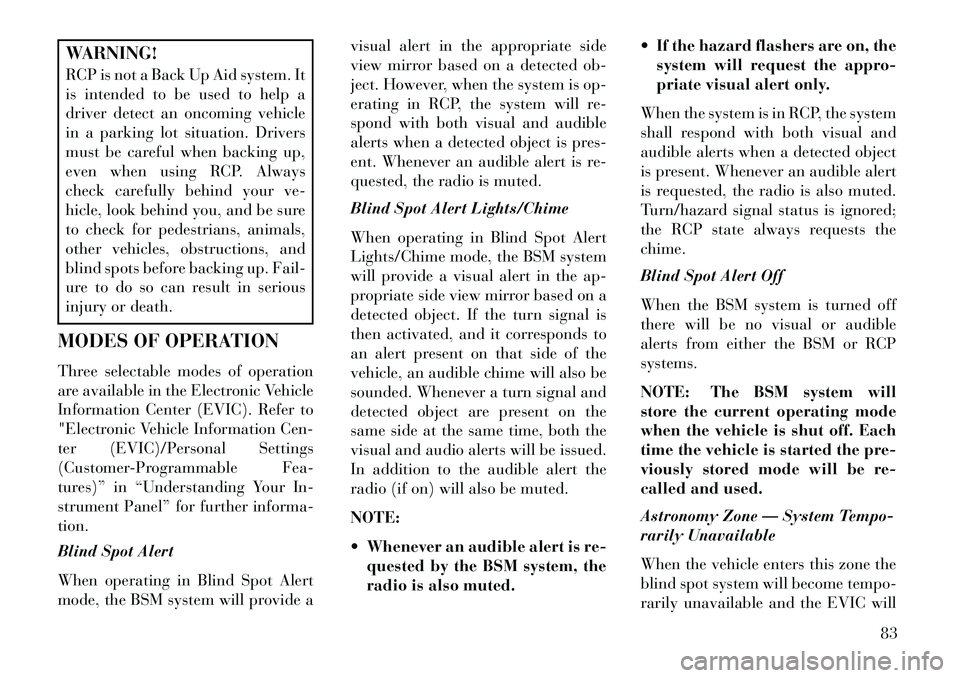
WARNING!
RCP is not a Back Up Aid system. It
is intended to be used to help a
driver detect an oncoming vehicle
in a parking lot situation. Drivers
must be careful when backing up,
even when using RCP. Always
check carefully behind your ve-
hicle, look behind you, and be sure
to check for pedestrians, animals,
other vehicles, obstructions, and
blind spots before backing up. Fail-
ure to do so can result in serious
injury or death.
MODES OF OPERATION
Three selectable modes of operation
are available in the Electronic Vehicle
Information Center (EVIC). Refer to
"Electronic Vehicle Information Cen-
ter (EVIC)/Personal Settings
(Customer-Programmable Fea-
tures)” in “Understanding Your In-
strument Panel” for further informa-
tion.
Blind Spot Alert
When operating in Blind Spot Alert
mode, the BSM system will provide a visual alert in the appropriate side
view mirror based on a detected ob-
ject. However, when the system is op-
erating in RCP, the system will re-
spond with both visual and audible
alerts when a detected object is pres-
ent. Whenever an audible alert is re-
quested, the radio is muted.
Blind Spot Alert Lights/Chime
When operating in Blind Spot Alert
Lights/Chime mode, the BSM system
will provide a visual alert in the ap-
propriate side view mirror based on a
detected object. If the turn signal is
then activated, and it corresponds to
an alert present on that side of the
vehicle, an audible chime will also be
sounded. Whenever a turn signal and
detected object are present on the
same side at the same time, both the
visual and audio alerts will be issued.
In addition to the audible alert the
radio (if on) will also be muted.
NOTE:
Whenever an audible alert is re-
quested by the BSM system, the
radio is also muted. If the hazard flashers are on, the
system will request the appro-
priate visual alert only.
When the system is in RCP, the system
shall respond with both visual and
audible alerts when a detected object
is present. Whenever an audible alert
is requested, the radio is also muted.
Turn/hazard signal status is ignored;
the RCP state always requests the
chime.
Blind Spot Alert Off
When the BSM system is turned off
there will be no visual or audible
alerts from either the BSM or RCP
systems.
NOTE: The BSM system will
store the current operating mode
when the vehicle is shut off. Each
time the vehicle is started the pre-
viously stored mode will be re-
called and used.
Astronomy Zone — System Tempo-
rarily Unavailable
When the vehicle enters this zone the
blind spot system will become tempo-
rarily unavailable and the EVIC will
83
Page 90 of 360
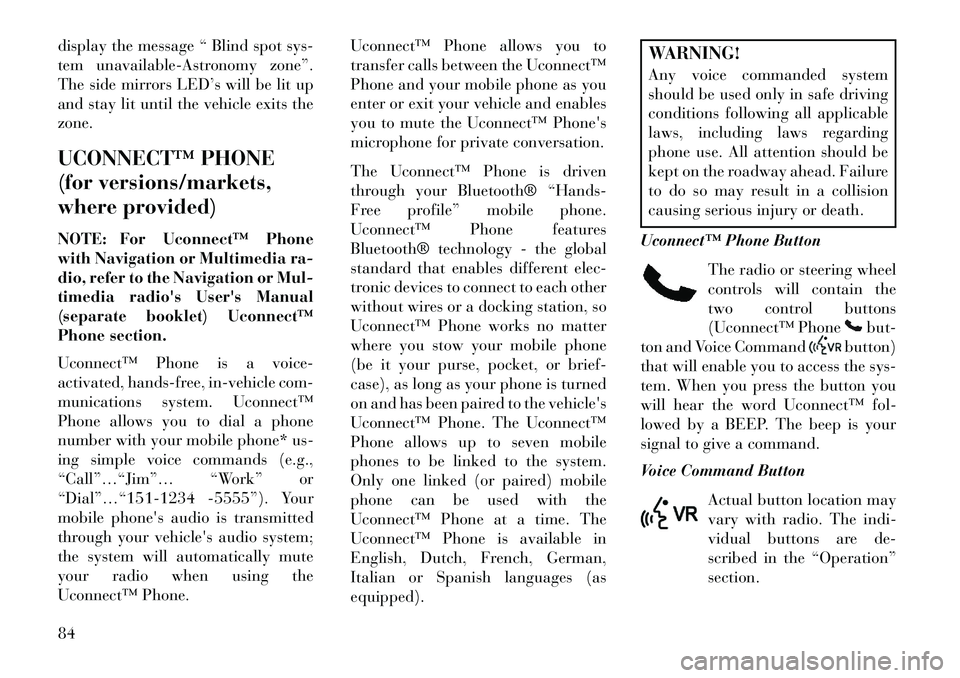
display the message “ Blind spot sys-
tem unavailable-Astronomy zone”.
The side mirrors LED’s will be lit up
and stay lit until the vehicle exits the
zone.
UCONNECT™ PHONE
(for versions/markets,
where provided)
NOTE: For Uconnect™ Phone
with Navigation or Multimedia ra-
dio, refer to the Navigation or Mul-
timedia radio's User's Manual
(separate booklet) Uconnect™
Phone section.
Uconnect™ Phone is a voice-
activated, hands-free, in-vehicle com-
munications system. Uconnect™
Phone allows you to dial a phone
number with your mobile phone* us-
ing simple voice commands (e.g.,
“Call”…“Jim”… “Work” or
“Dial”…“151-1234 -5555”). Your
mobile phone's audio is transmitted
through your vehicle's audio system;
the system will automatically mute
your radio when using the
Uconnect™ Phone.Uconnect™ Phone allows you to
transfer calls between the Uconnect™
Phone and your mobile phone as you
enter or exit your vehicle and enables
you to mute the Uconnect™ Phone's
microphone for private conversation.
The Uconnect™ Phone is driven
through your Bluetooth® “Hands-
Free profile” mobile phone.
Uconnect™ Phone features
Bluetooth® technology - the global
standard that enables different elec-
tronic devices to connect to each other
without wires or a docking station, so
Uconnect™ Phone works no matter
where you stow your mobile phone
(be it your purse, pocket, or brief-
case), as long as your phone is turned
on and has been paired to the vehicle's
Uconnect™ Phone. The Uconnect™
Phone allows up to seven mobile
phones to be linked to the system.
Only one linked (or paired) mobile
phone can be used with the
Uconnect™ Phone at a time. The
Uconnect™ Phone is available in
English, Dutch, French, German,
Italian or Spanish languages (as
equipped).
WARNING!
Any voice commanded system
should be used only in safe driving
conditions following all applicable
laws, including laws regarding
phone use. All attention should be
kept on the roadway ahead. Failure
to do so may result in a collision
causing serious injury or death.
Uconnect™ Phone Button The radio or steering wheel
controls will contain the
two control buttons
(Uconnect™ Phone
but-
ton and Voice Command
button)
that will enable you to access the sys-
tem. When you press the button you
will hear the word Uconnect™ fol-
lowed by a BEEP. The beep is your
signal to give a command.
Voice Command Button
Actual button location may
vary with radio. The indi-
vidual buttons are de-
scribed in the “Operation”
section.
84